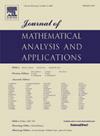Multi-bump solutions of the magnetic p-Laplacian Schrödinger equations with critical and logarithmic nonlinearities
IF 1.2
3区 数学
Q1 MATHEMATICS
Journal of Mathematical Analysis and Applications
Pub Date : 2025-09-25
DOI:10.1016/j.jmaa.2025.130093
引用次数: 0
Abstract
This paper focuses on the following magnetic p-Laplacian Schrödinger equations with critical and logarithmic nonlinearities in : where , , denotes the magnetic p-Laplacian, the magnetic potential and the parameters , are the nonnegative continuous functions, is the Sobolev critical exponent. Applying variational methods, multiple multi-bump solutions for the above equation have been obtained. More precisely, our findings demonstrate that if the zero set of Z possesses several isolated connected components such that the interior of is not empty and ∂Ω is smooth, then for sufficiently large, a bump solution is confined in a neighborhood of for every non-empty subset . Furthermore, let be large enough, we also show that the above equation has at least multi-bump solutions. The novelty and characteristic of this paper lie in the simultaneous appearance of critical and logarithmic nonlinearities in this equation, and the results in this paper extend the subcritical case [39] to the critical case.
具有临界和对数非线性的磁性p-拉普拉斯Schrödinger方程的多碰撞解
本文主要研究以下在RN中具有临界非线性和对数非线性的磁性p-拉普拉斯方程Schrödinger:−Δp,Au+(λZ(x)+V(x))|u|p - 2u=β|u|p - 2ulog (| u|p+|u|p 2u,x∈RN,其中N≥3,p∈[2,N], Δp,A=div(|∇u+iA(x)u|p - 2(∇u+iA(x)u))表示磁性p-拉普拉斯方程,磁位A∈Llocp(RN,RN)和参数λ,β≥1,Z(x),V(x):RN→R为非负连续函数,p =NpN−p为Sobolev临界指数。应用变分方法,得到了上述方程的多个多碰撞解。更准确地说,我们的研究结果证明,如果Z的零集具有几个孤立的连通分量Ω1,⋯,Ωk,使得Ωi的内部不是空的,∂Ω是光滑的,那么对于λ≥1足够大,对于每个非空子集Γ∧{1,⋯,k},一个凸起解被限制在一个邻域(∈ΓΩj)中。进一步,当λ≥1足够大时,我们还证明了上述方程至少有2k−1个多碰撞解。本文的新颖性和特点在于在该方程中同时出现临界非线性和对数非线性,并将亚临界情况[39]推广到临界情况。
本文章由计算机程序翻译,如有差异,请以英文原文为准。
求助全文
约1分钟内获得全文
求助全文
来源期刊
CiteScore
2.50
自引率
7.70%
发文量
790
审稿时长
6 months
期刊介绍:
The Journal of Mathematical Analysis and Applications presents papers that treat mathematical analysis and its numerous applications. The journal emphasizes articles devoted to the mathematical treatment of questions arising in physics, chemistry, biology, and engineering, particularly those that stress analytical aspects and novel problems and their solutions.
Papers are sought which employ one or more of the following areas of classical analysis:
• Analytic number theory
• Functional analysis and operator theory
• Real and harmonic analysis
• Complex analysis
• Numerical analysis
• Applied mathematics
• Partial differential equations
• Dynamical systems
• Control and Optimization
• Probability
• Mathematical biology
• Combinatorics
• Mathematical physics.

 求助内容:
求助内容: 应助结果提醒方式:
应助结果提醒方式:


